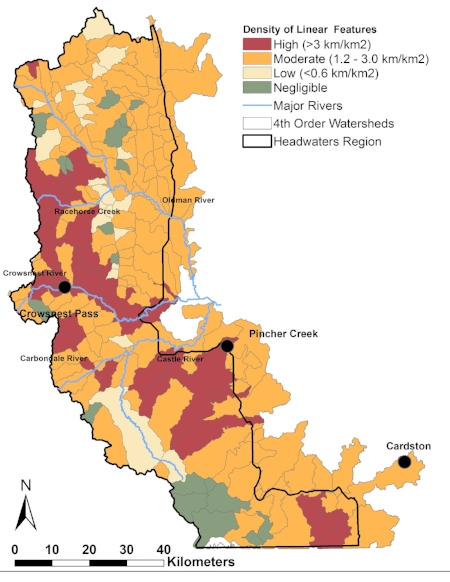Editor’s Note: On March 29, guest blogger Jordan Pinkster covered the main points of the draft Livingstone-Porcupine Hills Land Footprint and Recreation Management Plans in his blog Protecting what we Love, and now OWC is pleased to share its analysis. Be sure to complete both surveys on the Alberta Environment and Parks website by April 26 to voice your opinions.
The Government of Alberta's draft Livingstone-Porcupine Hills Land Footprint and Recreation Management Plans are a very positive step towards headwaters protection and essentially mirror what diverse stakeholders in the Oldman watershed agreed to and asked the Government of Alberta for, in OWC’s 2013-14 Headwaters Action Plan. OWC is pleased to see that the majority of the targets, actions, and recommendations from the Headwaters Action Plan will be addressed by the new draft Government of Alberta plans.
This alignment makes sense because in 2013-14, we took the same approach the Government of Alberta took, by using credible, well-established scientific thresholds and by involving a wide range of perspectives. In our case, stakeholders actually crafted the targets, actions, and recommendations themselves - they made the decisions. It also makes sense because the changes are what many recreationists, ranchers, municipalities, community organizations, and environmental groups have been asking for since the 1980s.
The primary strategy appears to be to reduce linear footprint, which also makes sense, because linear features are the root cause of many other issues. You can refresh your memory of linear features by re-reading our March 2, 2017 blog about this topic.
The density of linear features along the Eastern Slopes is too high for fish and wildlife to thrive.
This planning process is also a great example of how Watershed Planning and Advisory Councils advise the Government of Alberta. OWC helped get things moving by demonstrating that watershed health is declining and that our land is under high pressure; then we showed that people are ready to set clear targets, paving the way for management that puts water first.
These 2 draft plans are a turning point, a real watershed moment if you will, to halt declining environmental health and even restore it. In 2013-14 OWC’s Headwaters Indicator Project studied the health of our headwaters and found that nearly 80% of the area is experiencing high pressure and has low to moderate watershed integrity. As these plans become reality, watershed health will improve.
In 2013, OWC's research found that the health of the Eastern Slopes in the Oldman watershed has declined.
And that is the most critical point - will these plans that only exist on paper, be set in motion with enough backing to actually improve watershed health? Will there be funding and support to replant willows along stream banks, educate people about the new rules, build proper bridges and trails, install signs, etc.? These things aren’t free and won’t happen by themselves.
OWC has been on the ground for the last 3 years Engaging Recreationists and restoring streambanks, in partnership with Alberta Environment and Parks’ Watershed Resiliency and Restoration Program, Cows and Fish, Crowsnest Pass Quad Squad, Spray Lake Sawmills, and many others, and we hope these plans mean our work can continue and we can share our learnings with others.
We know that the best way to safeguard our watershed is by involving people in its stewardship, and that’s why we organize willow planting events and garbage clean ups, and help deck bridges and pull weeds. We advise the Government of Alberta to take this approach and are encouraged to see partnerships discussed in the implementation section of the draft plans.
OWC helps deck bridges to encourage motorized recreationists to steer clear of creeks.
If you enjoy camping and the great outdoors, chances are you’re wondering how these plans will impact you. Here is a snapshot:
- This summer, the new trail system is expected be in effect, and signs will be installed to direct people to designated trails and to stay off of closed trails.
- For off highway vehicle users, the number of trails will decline and for hikers, mountain bikers and horseback riders, the number of (single track) trails will not change much.
- Properly constructed trails and bridges are promised over waterways to reduce sedimentation.
- Random camping will still be permitted in most areas but buffer zones will be established surrounding creeks and rivers, to allow streambank vegetation to grow back.
- Many existing staging areas and random camping areas will remain. Tickets can be issued for those breaking the law, however education will be the main focus at first, to get people used to the new rules.
For those who enjoy off roading these plans are a big change, and as a community we need to be understanding that no one enjoys giving something up that they have become used to. These are places where people have created memories and are an extension of ‘home’.
OWC Outreach Assistants encourage all recreationists to minimize their impact on the backcountry.
Change takes us outside our comfort zones, but we need to remember that we are all downstream. We rely on these headwaters for our water supply. We also value this place for time away from our stressful lives, a chance to see wildlife, to catch a fish, or go for a swim. Most importantly to spend time with our friends and family. With these new plans, we can still do all of these things, and we can ensure our children and grandchildren have the same experiences.
We may need to stop riding on certain trails or move our camper away from the creek, but ultimately we can still experience all the same activities and even discover new ones.
What OWC is hearing is concern that we will lose a way of life, a freedom to be a part of nature, and that there will be so many rules and signs that the backcountry will no longer feel wild and free but structured, like the city. These worries are normal when changes happen, but the plans do provide ample backcountry experiences. In fact, the plans create more wild spaces through reclamation but you may need to walk, bike, or ride a horse to get to them.
At the end of the day it is the Government’s job to make the tough decisions on behalf of all of us, and this time it was not easy or quick. The Alberta Land Stewardship Act was established in October 2009, and discussion and debate about public land management has continued over the entire 9 years. The South Saskatchewan Regional Plan of September 2014 stated that these draft plans were coming, and now 3.5 years later, after much debate and consultation, they have arrived.
OWC supports the draft Livingstone-Porcupine Hills Land Footprint Plan and Recreation Plan because it strikes a balance between all interests and will improve the health of the Oldman watershed once it is implemented on the ground.









